Pickup Trucks 101: Choosing the Right Winch
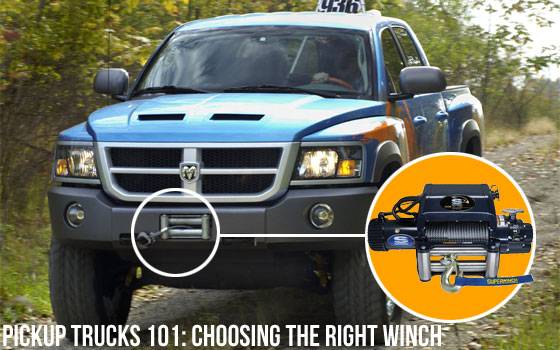
When you take your truck into the backcountry, it’s more than likely you’ll encounter large rocks, mud, snow or sand. Although your off-road driving skills may allow you to conquer this type of terrain, you may want to consider some insurance in the form of a self-recovery winch.
A winch mounted on your truck will allow you to get out of just about any stuck situation. You may not use it often, but it will more than pay for itself the first time you really need it.
A winch is definitely an investment in your off-road adventures, so it’s wise to do your research before buying one. A variety of winches can handle everything from a lightweight ATV to a full-size truck, like a Ford F-150 SuperCrew or Chevy 2500 HD. Some trucks, like the Ram 2500 Power Wagon, come equipped with a Warn 12,000-pound front-mounted winch that’s integrated into the factory front bumper. But to attach a winch to your pickup, you’ll have to consider using a new bumper or push bar with a winch mount. Another option is to use a hidden winch mount that will allow you to attach and remove the winch to the front and/or rear of your pickup, much like a towing hitch.
Choose the mounting method first, as not all winch manufacturers work with every bumper or push bar available. Most advanced off-road enthusiasts and professional off-road racers recommend starting with a front-mounted winch. Mounting the winch at the front of the vehicle allows a better line of sight to help you drive out of a situation, using the winch as an aid.
Capacity
Winches vary in size and capabilities, so the next step is to narrow down your choices by properly matching the unit’s pulling strength to your pickup truck. A common rule of thumb is to simply double the weight of your vehicle. Midsize pickups like a Toyota Tacoma or Nissan Frontier can use a 9,000- to 9,500-pound-capacity winch. Full-size trucks like a Ford F-150 or Chevy 1500 require at least a 12,000- or 12,500-pound-capacity winch. For a bigger truck — such as a diesel with lots of accessories, big wheels and more — there are winches that can handle 16,500 to 18,000 pounds.
If you’re still not sure, consider getting a winch with more capacity. Bigger is better in this situation, and it can also put less strain on the winch and extend its service life. But you don’t need to go overboard and consider the unit’s physical size. Typically, larger-capacity winches have larger motors and line spools, so you’ll have to compare information from various winch makers to see what works best with the weight of your truck and how it will be mounted.
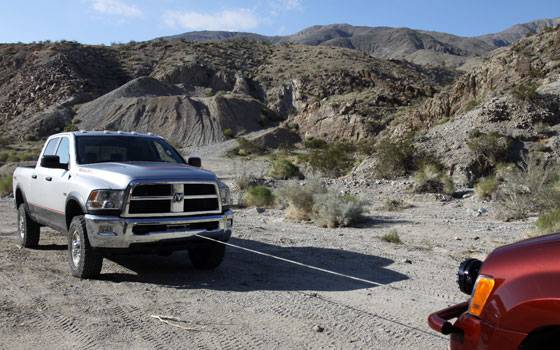
Electric or Hydraulic?
Winches are powered two different ways. The most common are electric winches, which use the vehicle’s battery power to turn the motor. Electric winches typically have faster winding speed and are somewhat easier to install. They also offer the advantage of using a remote control that allows you to stand safely away from the winch and vehicle during recovery.
Because an electric winch draws lots of power from your truck’s electrical system, it’s important to make sure there’s enough power to operate it. Look at the winch manufacturer’s amperage rating and make sure your vehicle’s battery and alternator can deliver the necessary amperage to run it at full capacity, even with the headlights on. If not, you may need to upgrade to a dual-battery system or a higher-output alternator.
Hydraulic winches typically use the vehicle’s power steering pump to wind up the winch line. Many enthusiasts swear by hydraulic winches, as they are extremely reliable and not affected by water or low battery power. This is a reason why they are commonly used in areas with lots of mud or water. As long as the truck’s engine is still running, a hydraulic winch can pull you out of any situation. But since there’s extra plumbing and hydraulic lines to add, not all hydraulic winches fit on every truck or mounting application.
Steel Cable or Synthetic?
Winch manufacturers now offer a choice of using a steel or synthetic winch line. Steel is the most common, and for obvious reasons. It’s incredibly strong, lasts a long time and resists abrasions against rocks. Over time, however, steel cables will corrode, fray and sometimes break. If this happens under tension, a steel cable can cause serious injury because of the amount of potential energy stored in the cable.
This is why many off-road-racing sanctioning bodies and off-road events require using only synthetic winch lines. By far, synthetic lines are lighter and hold less potential energy. So if they snap under tension, there’s less chance of injury or damage. While a synthetic line is much lighter than a steel cable, it is also much stronger. But a synthetic line doesn’t resist abrasions well and will eventually snap if it’s constantly rubbed against rocks or dirt.
Most experienced off-road enthusiasts recommend learning safety self-recovery techniques with a steel cable first. Once you’ve learned how to secure the line and care for it properly, you can move to a lighter synthetic line and avoid any unnecessary contact to minimize abrasions.
Winches
There’s a wide range and variety of winches. We’ve compiled some of the newest with some of the features that most pickup truck owners like. Contact the manufacturers to get more info, and talk to other truck owners to see which winch they prefer and have experience with. This information — along with assisting or learning proper winch techniques from an experienced enthusiast or off-road backcountry guide — can help you tremendously before you buy your first winch.
Warn XC9000i
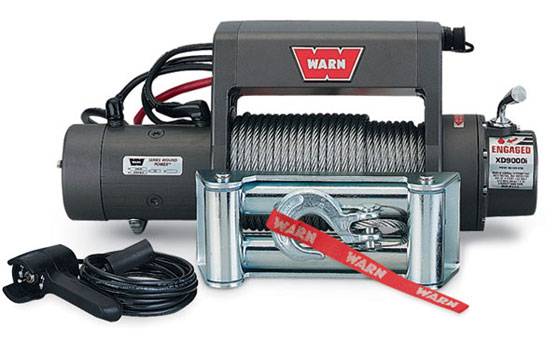
Touted as one of the premium winches in the Warn line, the XC9000i has a 9,000-pound pull capacity and runs cooler with a low amperage draw (maximum 460 amps at 9,000 pounds of pull, 6.38 feet per minute line speed). This winch uses a three-stage planetary gear system and weighs 85 pounds. It comes with a remote control and comes in a full-metal protective housing. www.warn.com
Warn PowerPlant HD
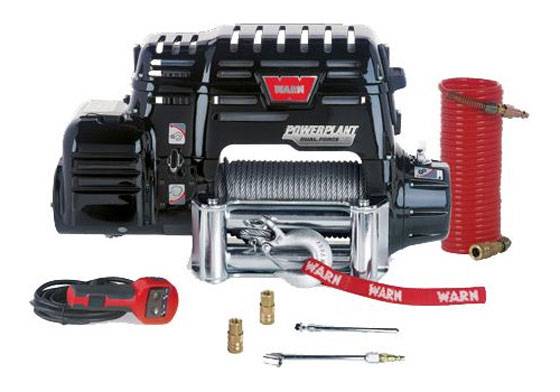
This heavy-duty winch comes complete with an integrated air compressor, and the unit weighs 115 pounds. It features a three-stage planetary gear system, a very high duty cycle rating and a low amperage draw of 416 amps at 12,000 pounds of pull (3.6 feet per minute line speed). The built-in air compressor puts out 5 cubic feet per minute at 90 pounds per square inch. It also has a 4.6-horsepower motor and an air tank and intercooler that allow the unit to fill up four 35-inch-diameter tires in eight minutes or less. www.warn.com
Superwinch Talon 12.5 SR

This 12,000-pound-capacity winch features a 6-hp motor and a two-stage planetary gear system that makes it fast and lightweight. The SR designation means it uses synthetic rope, Superwinch’s AmSteel Blue with a Samthane coating that helps the rope resist abrasions. At 12,500 pounds of line pull, the Talon 12.5 draws 530 amps and has a line speed of 3.25 feet per minute. The Talon 12.5 is also available with a steel cable and weighs 94 pounds. www.superwinch.com
Superwinch Talon 9.5i
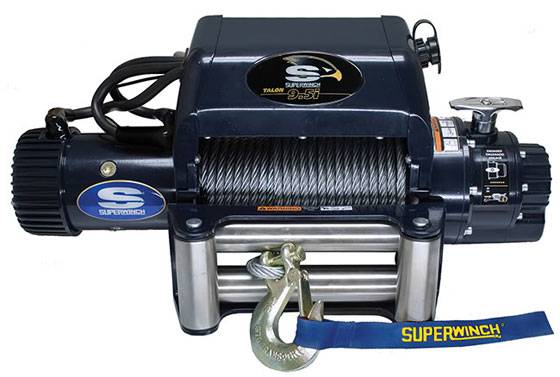
Midsize and some full-size trucks can take advantage of the Superwinch Talon 9.51’s lighter weight. This winch has 9,500 pounds of line pull and draws 430 amps with a line speed of 5 feet per minute. The Talon 9.5i uses a two-stage planetary gear system and is also available with synthetic rope (Talon 9.5i SR). The winch weighs 67 pounds installed. www.superwinch.com
Mile Marker V-10
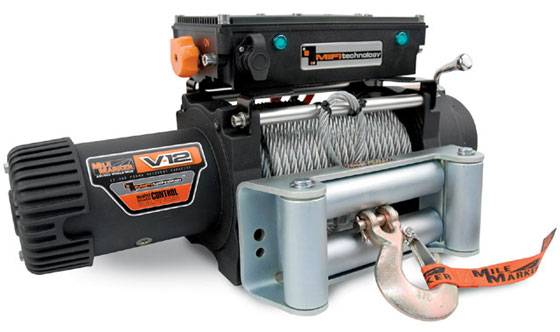
Mile Marker’s V-Series winches feature solid-state Mi-Fi electronics that allow you to control the line speed with a hand-held remote. This technology eliminates the traditional solenoids that can wear out or fail over time. The V-10 model uses a three-stage planetary gear system and a 6.5-hp motor and weighs 102 pounds installed. It pulls 10,000 pounds, drawing 385 amps at a maximum line speed of 8.1 feet per minute. The V-12 model pulls 12,000 pounds, weighs 102 pounds and draws 380 amps with a line speed of 6.1 feet per minute. www.milemarker.com
Mile Marker H1200
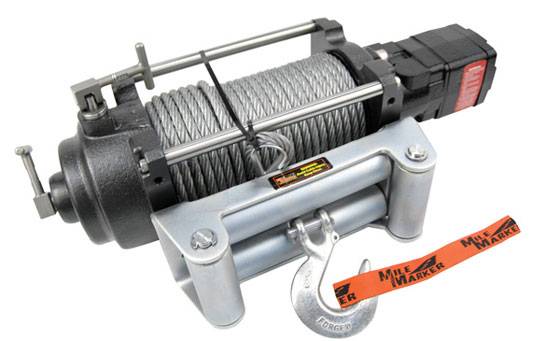
This hydraulic winch has a 12,000-pound pull rating and uses a separate solenoid control valve that gives it more mounting options. This two-speed winch has a line speed of 5.65 feet per minute in low gear (12,000 pounds) and 31 feet per minute in high gear (maximum 2,000 pounds). The ductile iron body is corrosion-resistant and weighs 98 pounds. The winch can also be operated if it’s fully submerged in water. www.milemarker.com
Ramsey Patriot 9500 UT

The Ramsey 9500 UT has a 9,500-pound pull rating and weighs 93 pounds. At maximum load, it has a line speed of 7.8 feet per minute (at 9,500 pounds) and draws 430 amps. Ramsey’s semi-automatic clutch and 5.5-hp motor reduce winching time, and a wireless remote control key fob can operate the winch from up to 50 feet away. www.ramsey.com
Ramsey Patriot 15000
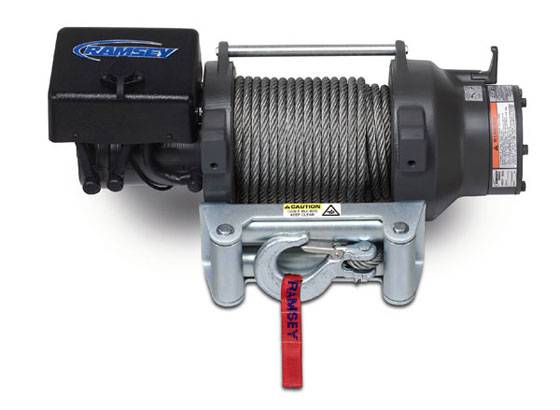
This heavy-duty winch pulls up to 15,000 pounds and weighs 120 pounds installed. At maximum load, it draws 460 amps and has a line speed of 3.9 feet per minute. The Patriot 15000 uses a 5.5-hp motor and a three-stage planetary gear system. It also features a compact body with an integrated solenoid system, and it has a four-roller fairlead. It can be used with a wired or wireless remote control. www.ramsey.com
Cars.com’s Editorial department is your source for automotive news and reviews. In line with Cars.com’s long-standing ethics policy, editors and reviewers don’t accept gifts or free trips from automakers. The Editorial department is independent of Cars.com’s advertising, sales and sponsored content departments.
Featured stories




